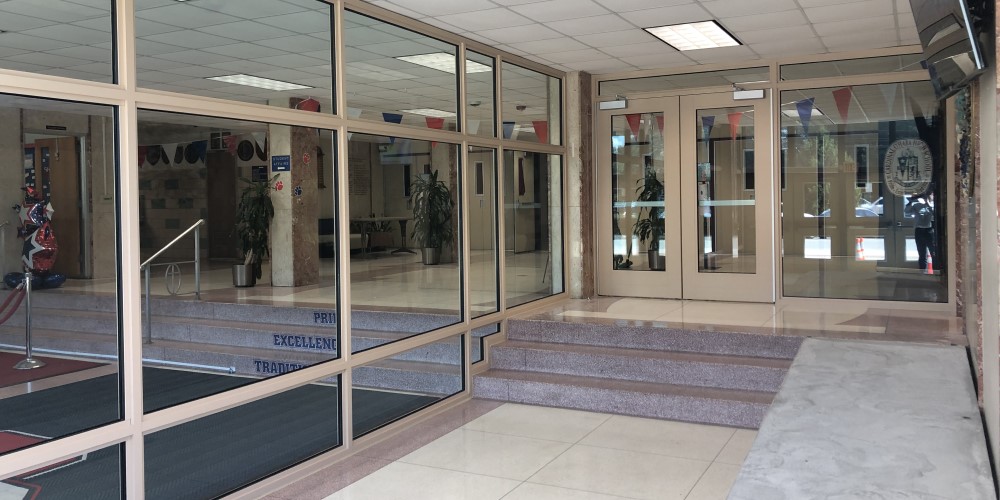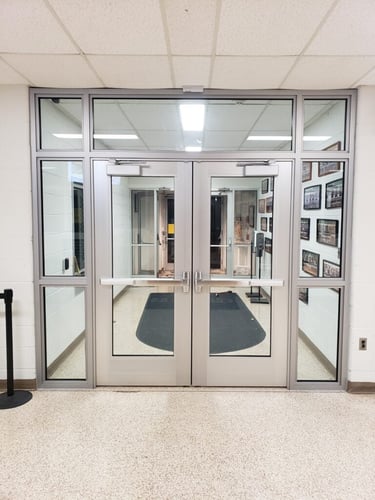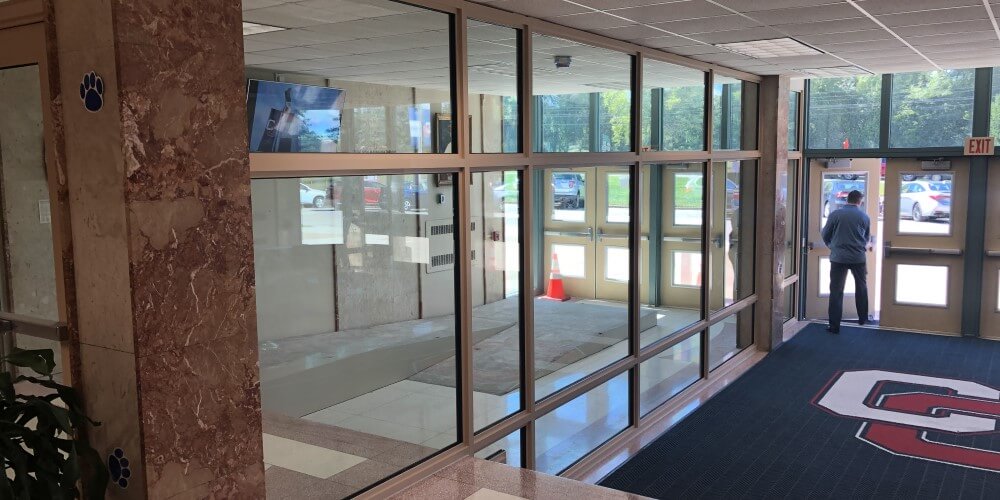As of summer 2023, new legislation in eight states mandates increased school security, including ballistic security. In many cases, these new laws especially focus on entryways.
- The 2023 modifications to Tennessee's Schools Against Violence in Education Act require "one secure vestibule that serves as the primary entrance to the school building and that contains two separate sets of doors" and security film on all exterior windows.
- A bill working its way through the Missouri House of Representatives will require "a school district to have bullet-resistant doors and windows on all first-floor entryways and bullet-resistant glass for each exterior window large enough for an intruder to enter through" for the 2023-2024 school year.
- Since 2018, Delaware has required that school entryway vestibules, lobbies, and offices have bullet-resistant glass and walls.
Gregg Knappe is an account manager at Total Security Solutions. There, he specializes in ballistic security solutions for educational institutions ranging from pre-K and daycares to K–12 schools, colleges, and universities.
"Unfortunately," he notes, "cost and budget are always a factor in education. It's not feasible, money-wise, to just replace everything with bullet-resistant. But starting at that main entrance is key. That's where I would start with any school."
Three School Security Solutions at the Entryway
Broadly speaking, there are three approaches to school entryway security:
- Harden the exterior doors
- Secure the vestibule
- Add an "interior storefront"
At one time, hardening the exterior was the solution at the entryway: replace the existing exterior school entrance doors with bulletproof equivalents, add an access control system that can be controlled remotely, and install an intercom next to the door so the receptionist can communicate with visitors before buzzing anyone in.
About ten years ago, TSS pioneered the secure vestibule. Many schools already have vestibules, to keep inclement weather out of the building and reduce strain on their HVAC systems and custodial teams. That vestibule can be transformed into a secure "mantrap" (which is what’s described in the Tennessee law): leave the exterior doors as they are, and replace the interior doors with ballistic equivalents outfitted with an access control system. In many cases, the school's layout makes it possible to add a bullet-resistant reception window in that vestibule as well, so the receptionist can speak with visitors or accept deliveries without allowing access further into the school.
More recently, TSS has been building so-called "interior storefronts." (A "storefront," in ballistic security, is a floor-to-ceiling window-wall with at least one door—similar to the street-level display and entrance to a store.) This creates secure, vestibule-like functionality in a building that previously had no vestibule. It also makes it possible to offer greater security to a wide range of building layouts without impeding the day-to-day passing of thousands of kids, teachers, and support staff to and from school. (TSS's recent work at Cardinal O’Hara High School outside Philadelphia is a good example of the flexibility of the "interior storefront" design.)

Choosing Your School Entryway Security Solution
The three approaches to school entryway security listed above aren't ordered from least to most expensive, or least to most secure.
"I know it's cliche or seems vague," Gregg is quick to explain, "but this really is about what's the best solution for your school, given your building layout and uses and your budget. If that means replacing just the exterior doors, that's what we'll do. But that's not necessarily less expensive than adding a ballistic 'second storefront' right behind it to create a vestibule."
At one time, the bulk of TSS's school security work was in replacing exterior doors. Today, the interior storefront approach is more than 50% of what they do for schools.
This arises from TSS's systems-focused consultative approach to school security. As Gregg explains: "I always start by asking What is the main concern and how can we address it? It might not be possible to do certain things, just based on cost or the specifics of the materials. For example, if they want something that's rifle protection, but only want to replace the glass while leaving the frames intact—that's not physically possible. There's no material that fits that description. But we can always make that school safer while maintaining the atmosphere. That starts with understanding what their need is, identifying that specific need, listening to them, and figuring that out together."
What "Level" of Ballistic Glass Does a School Need?
True bullet-resistant glass is always rated by a third-party laboratory, generally according to the UL-752 standard. (Although there are other bulletproof standards, they usually aren't entirely appropriate for fixed barriers in schools). In most cases, schools will want Level 3 ballistic materials. These are rated to stop multiple shots from any handgun. Although several Level 3 glazings are available, most schools are now primarily using glass-clad polycarbonate (or GCP) owing to its performance and durability (especially against inclement weather, long-term UV exposure, and the constant touching, tapping, scrapping, and bumping that comes with being in a school setting).
In addition to stopping bullets, GCP always offers some degree of inherent resistance to brute force. Because it is a laminated product (i.e., it's composed of many thin sheets of glass, polycarbonate, and other materials), it is possible to get a wide range of "custom makeups." That means there are many options for tints, mirror-coating, low-E coats, and enhanced forced-entry or blast rating.
While a school certainly could choose to go with a higher level of security, this often isn't practical because of the thickness and weight of high-level bullet-resistant windows and doors. Gregg points out "If you're at an elementary school and you're looking for level eight doors," which are rated to stop multiple bursts from military-grade rifles, "then you're talking about a thousand-pound door, literally. The glass alone is nearly three inches thick. Can four-year-olds going to pre-K open a thousand-pound door? Probably not."

Why Not Just "Swap the Glass?”
Contractors and integrators working on school security projects often ask if it's possible to just "swap out" the existing non-rated doors for bullet-resistant equivalents.
Unfortunately, that's rarely the case now. The Level 3 GCP that most schools want is too heavy and thick to fit into standard commercial framing. Yes, there are lower level ballistic materials (like Level 1 and 2 polycarbonate) that can fit in the commercial frames schools typically have. But fewer schools are opting to use these materials, both because they offer less security and are less durable. All-polycarbonate glazing tends to scuff and scratch easily and discolors when exposed to UV over time.
That said, Gregg notes that school buildings are all unique, and there are many options to suit different uses, even in a single building. "It all depends. For example, part of the building might be always in full sun, but a lower risk area. So they might want to have glass that's forced-entry rated and insulated or tinted, even if the ballistic security isn't as high. Throughout the building, based on location and threat scenario and other factors, they might choose different ballistic glass or window treatment or framing."
Increasing school entryway security is almost invariably the single most cost-effective way a school can quickly improve safety and security. TSS offers a variety of free resources for schools planning a security upgrade, including a school security solutions planning timeline (updated for 2023) and this Five Step Guide for Securing School Entryways.
Questions? Ready to get started with a specific project? Contact our ballistic security experts whenever you're ready.

